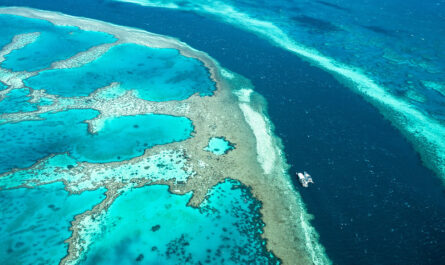The Pacific Ocean, the largest and deepest ocean on Earth, is home to some of the planet’s most extraordinary geological and ecological features. Among these are volcanic ecosystems, which play a pivotal role in shaping the deep-sea environment. These ecosystems, born from volcanic activity, provide critical habitats, drive biogeochemical processes, and support a unique array of life forms that thrive in extreme conditions.
This article explores the fascinating world of volcanic ecosystems in the Pacific’s deep waters, their significance to global ecology, and the challenges they face in a rapidly changing world.
Understanding Volcanic Ecosystems in the Pacific
Volcanic ecosystems in the Pacific are formed around underwater volcanoes, also known as seamounts, and hydrothermal vents. These geological formations are the result of tectonic activity along the Pacific Ring of Fire, a horseshoe-shaped zone characterized by frequent earthquakes and volcanic eruptions.
Key Features of Volcanic Ecosystems
- Seamounts:
Seamounts are underwater mountains formed by volcanic activity. Rising from the ocean floor, they provide hard substrates for marine life to attach and flourish. Seamounts are biodiversity hotspots, supporting coral reefs, sponges, and a wide variety of fish species. - Hydrothermal Vents:
Hydrothermal vents are fissures on the seafloor where superheated water rich in minerals is expelled. These vents create extreme environments with temperatures reaching up to 400°C (752°F). Despite the harsh conditions, hydrothermal vents are home to unique ecosystems powered by chemosynthesis rather than photosynthesis. - Submarine Volcanoes:
Active submarine volcanoes contribute to the creation of new habitats by releasing lava, which solidifies into rocky surfaces. Over time, these areas are colonized by marine organisms, forming dynamic ecosystems.
The Ecological Importance of Volcanic Ecosystems
Volcanic ecosystems in the Pacific are critical to maintaining the health and balance of deep-sea environments.
1. Biodiversity Hotspots
Seamounts and hydrothermal vents support a remarkable diversity of life, including species found nowhere else on Earth. These ecosystems are home to:
- Chemosynthetic Organisms: Bacteria and archaea that use chemical energy from vent fluids to produce organic matter.
- Specialized Fauna: Giant tube worms, deep-sea crabs, and vent-specific fish species have evolved to thrive in these extreme environments.
- Migratory Species: Seamounts act as feeding and breeding grounds for species like tuna, sharks, and whales.
2. Nutrient Cycling
Volcanic ecosystems play a vital role in nutrient cycling in the ocean. Hydrothermal vents release minerals such as iron, sulfur, and manganese into the water column, which are essential for phytoplankton growth. This, in turn, supports the broader marine food web.
3. Carbon Sequestration
Deep-sea volcanic ecosystems contribute to carbon sequestration through processes like the deposition of organic matter and the formation of carbonate structures. These processes help regulate global carbon levels and mitigate climate change.
4. Geological Insights
Studying volcanic ecosystems provides valuable insights into Earth’s geological processes, including plate tectonics, magma formation, and mineral deposition.
Adaptations of Life in Volcanic Ecosystems
The organisms inhabiting volcanic ecosystems have developed remarkable adaptations to survive in extreme conditions:
- Thermal Tolerance: Many species can withstand high temperatures near hydrothermal vents.
- Pressure Resistance: Life at great depths endures immense pressure, which can exceed 1,000 times atmospheric pressure at sea level.
- Chemosynthesis: Instead of relying on sunlight, organisms like bacteria use hydrogen sulfide or methane from vent fluids as an energy source.
- Symbiosis: Many vent animals, such as tube worms, have symbiotic relationships with chemosynthetic bacteria, which provide them with nutrients.
Human Impacts on Volcanic Ecosystems
Despite their remoteness, volcanic ecosystems in the Pacific are increasingly threatened by human activities.
1. Deep-Sea Mining
The mineral-rich deposits around hydrothermal vents and seamounts have attracted interest for deep-sea mining. Extracting metals like cobalt, manganese, and rare earth elements can destroy fragile habitats and disrupt ecosystems.
2. Climate Change
Rising ocean temperatures and acidification pose significant threats to volcanic ecosystems. Changes in water chemistry can affect the delicate balance of life around hydrothermal vents and seamounts.
3. Overfishing
Seamounts are often targeted by commercial fisheries due to their high productivity. Overfishing can deplete fish stocks and disrupt the ecological balance.
4. Pollution
Marine debris, including plastic waste, has been found even in the deepest parts of the Pacific. Pollution can smother habitats and introduce toxins into the food chain.
Conservation and Research Efforts
Efforts to protect volcanic ecosystems in the Pacific are gaining momentum, driven by the need to preserve their ecological and scientific value.
1. Marine Protected Areas (MPAs)
Establishing MPAs around seamounts and hydrothermal vents helps safeguard these ecosystems from human exploitation. Notable examples include the Phoenix Islands Protected Area and the Marianas Trench Marine National Monument.
2. International Collaboration
Organizations like the Intergovernmental Oceanographic Commission (IOC) and the International Seabed Authority (ISA) work to regulate activities such as deep-sea mining and promote sustainable practices.
3. Deep-Sea Exploration
Advances in technology, such as remotely operated vehicles (ROVs) and autonomous underwater vehicles (AUVs), enable scientists to explore and monitor volcanic ecosystems. Research initiatives like NOAA’s Okeanos Explorer contribute valuable data for conservation efforts.
4. Public Awareness
Raising awareness about the importance of volcanic ecosystems can inspire support for conservation initiatives. Educational programs, documentaries, and citizen science projects play a crucial role in engaging the public.
Future Prospects
The future of volcanic ecosystems in the Pacific hinges on balancing conservation with sustainable resource use. Key areas of focus include:
- Sustainable Development: Developing guidelines for activities like deep-sea mining to minimize environmental impacts.
- Climate Action: Reducing greenhouse gas emissions to mitigate the effects of climate change on deep-sea ecosystems.
- Biodiversity Protection: Expanding the network of MPAs to cover more volcanic ecosystems and their surrounding waters.
Conclusion
Volcanic ecosystems in the Pacific’s deep waters are among the most fascinating and ecologically significant environments on Earth. From supporting unique biodiversity to driving essential nutrient cycles, these ecosystems play a crucial role in the health of our oceans.
However, they face mounting threats from human activities and environmental changes. Protecting these fragile habitats requires concerted efforts from scientists, policymakers, and the global community. By valuing and preserving volcanic ecosystems, we can ensure that their wonders continue to benefit future generations while deepening our understanding of the planet’s hidden depths.



